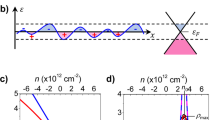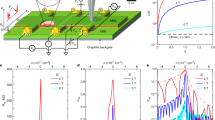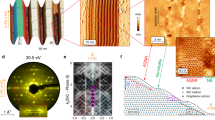Abstract
Electrical transport studies on graphene have been focused mainly on the linear dispersion region around the Fermi level1,2 and, in particular, on the effects associated with the quasiparticles in graphene behaving as relativistic particles known as Dirac fermions3,4,5. However, some theoretical work has suggested that several features of electron transport in graphene are better described by conventional semiconductor physics6,7. Here we use scanning photocurrent microscopy to explore the impact of electrical contacts and sheet edges on charge transport through graphene devices. The photocurrent distribution reveals the presence of potential steps that act as transport barriers at the metal contacts. Modulations in the electrical potential within the graphene sheets are also observed. Moreover, we find that the transition from the p- to n-type regime induced by electrostatic gating does not occur homogeneously within the sheets. Instead, at low carrier densities we observe the formation of p-type conducting edges surrounding a central n-type channel.
This is a preview of subscription content, access via your institution
Access options
Subscribe to this journal
Receive 12 print issues and online access
$259.00 per year
only $21.58 per issue
Buy this article
- Purchase on Springer Link
- Instant access to full article PDF
Prices may be subject to local taxes which are calculated during checkout




Similar content being viewed by others
References
Novoselov, K. S. et al. Electric field effect in atomically thin carbon films. Science 306, 666–669 (2004).
Geim, A. K. & Novoselov, K. S. The rise of graphene. Nature Mater. 6, 183–191 (2007).
Novoselov, K. S. et al. Two-dimensional gas of massless Dirac fermions in graphene. Nature 438, 197–200 (2005).
Zhang, Y., Tan, J. W., Stormer, H. L. & Kim, P. Experimental observation of the quantum Hall effect and Berry's phase in graphene. Nature 438, 201–204 (2005).
Katsnelson, M. I., Novoselov, K. S. & Geim, A. K. Chiral tunneling and the Klein paradox in graphene. Nature Phys. 2, 620–625 (2006).
Hwang, E. H., Adam, S. & Das Sarma, S. Carrier transport in two-dimensional graphene layers. Phys. Rev. Lett. 98, 186806 (2007).
Adam, S., Hwang, E. H., Galitski, V. M. & Das Sarma, S. A self-consistent theory for graphene transport. Proc. Natl Acad. Sci. USA 104, 18392–18397 (2007).
Martin, J. et al. Observation of electron–hole puddles in graphene using a scanning single-electron transistor. Nature Phys. 4, 144–148 (2008).
Tan, Y. W. et al. Measurement of scattering rate and minimum conductivity in graphene. Phys. Rev. Lett. 99, 246803 (2007).
Rossi, E. & Das Sarma, S. Ground-state of graphene in the presence of random charge impurities. Preprint at <http://arxiv.org/abs/0803.0963> (2008).
Polini, M., Tomadin, A., Asgari, R. & MacDonald, A. H. Density-functional theory of graphene sheets. Preprint at <http://arxiv.org/abs/0803.4150> (2008).
Sze, S. M. Physics of Semiconductor Devices (Wiley, New York, 2007).
Giovannetti, G. et al. Doping graphene with metal contacts. Preprint at <http://arxiv.org/abs/0802.2267v2> (2008).
Golizadeh-Mojarad, R. & Datta, S. Effect of the contact induced states on minimum conductivity in graphene. Preprint at <http://arxiv.org/abs/0710.2727> (2007).
Huard, B., Stander, N., Sulpizio, J. A. & Goldhaber-Gordon, D. Evidence of the role of contacts on the observed electron–hole symmetry in graphene. Preprint at <http://arxiv.org/abs/0804.2040v1> (2008).
Balasubramanian, K. et al. Photoelectronic transport imaging of individual semiconducting carbon nanotubes. Appl. Phys. Lett. 84, 2400–2402 (2004).
Balasubramanian, K., Burghard, M., Kern, K., Scolari, M. & Mews, A. Photocurrent imaging of charge transport barriers in carbon nanotube devices. Nano Lett. 5, 507–510 (2005).
Lee, E. J. H. et al. Electronic band structure mapping of nanotube transistors by scanning photocurrent microscopy. Small 3, 2038–2042 (2007).
Freitag, M. et al. Imaging of the Schottky barriers and charge depletion in carbon nanotube transistors. Nano Lett. 7, 2037–2042 (2007).
Ahn, Y., Dunning, J. & Park, J. Scanning photocurrent imaging and electronic band studies in silicon nanowire field effect transistors. Nano Lett. 5, 1367–1370 (2005).
Ferrari, A. C. et al. Raman spectrum of graphene and graphene layers. Phys. Rev. Lett. 97, 187401 (2006).
Horcas, I. et al. WSxM: a software for scanning probe microscopy and a tool for nanotechnology. Rev. Sci. Instrum. 78, 013705 (2007).
Graf, D. et al. Spatially-resolved Raman spectroscopy of single- and few-layer graphene. Nano Lett. 7, 238–242 (2007).
Blake, P. et al. Making graphene visible. Appl. Phys. Lett. 91, 063124 (2007).
Roddaro, S., Pingue, P., Piazza, V., Pellegrini, V. & Beltram, F. The optical visibility of graphene: interference colours of ultrathin graphite on SiO2 . Nano Lett. 7, 2707–2710 (2007).
Piscanec, S., Lazzeri, M., Mauri, F., Ferrari, A. C. & Robertson, J. Kohn anomalies and electron–phonon interactions in graphite. Phys. Rev. Lett. 93, 185503 (2004).
Hansen, W. N. & Johnson, K. B. Work function measurements in gas ambient. Surf. Sci. 316, 373–382 (1994).
Klusek, Z. et al. Local electronic edge states of graphene layer deposited on Ir(111) surface studied by STM/CITS. Appl. Surf. Sci. 252, 1221–1227 (2005).
Acknowledgements
The authors gratefully thank J. Smet and D. Obergfell for help with the preparation of the graphene monolayers, and A. Forment-Aliaga and A. Sagar for the Raman spectroscopy measurements.
Author information
Authors and Affiliations
Corresponding author
Supplementary information
Rights and permissions
About this article
Cite this article
Lee, E., Balasubramanian, K., Weitz, R. et al. Contact and edge effects in graphene devices. Nature Nanotech 3, 486–490 (2008). https://doi.org/10.1038/nnano.2008.172
Received:
Accepted:
Published:
Issue Date:
DOI: https://doi.org/10.1038/nnano.2008.172
This article is cited by
-
Pure edge-contact devices on single-layer-CVD-graphene integrated into a single chip
Scientific Reports (2023)
-
Inferring the energy sensitivity and band gap of electronic transport in a network of carbon nanotubes
Scientific Reports (2022)
-
An Effort Towards Full Graphene Photodetectors
Photonic Sensors (2022)
-
Photocurrent response in few-layered ReS2 devices with short and open circuits
Journal of the Korean Physical Society (2022)
-
Graphene nanoribbons for quantum electronics
Nature Reviews Physics (2021)



